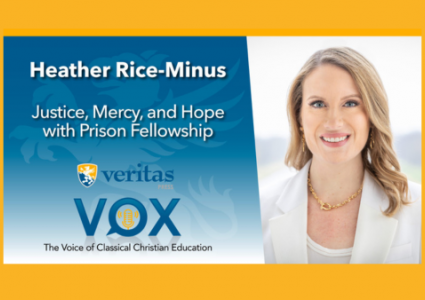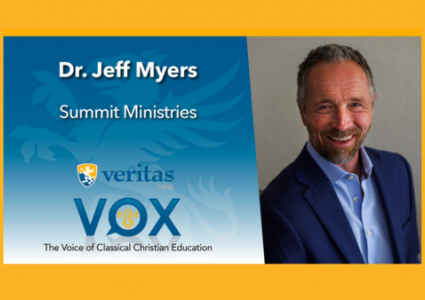What exactly is classical Christian education?
So what exactly is classical Christian education? As with any movement that becomes popular, classical Christian education can suffer from misleading caricatures and misrepresentations. We’ve often heard people suggest that classical Christian education is just going back. Immediately, images of men stuffed in togas, dusty museum pieces, and papyrus come to mind. Are we expecting your children to write on wax with a stylus, eschewing modern technology? Do we really want our children to be transported back in time to a golden bygone era? Is this movement nothing more than an elaborately constructed way to satisfy our nostalgia for the past? Our answer is a resounding "No!"
Far from being a nostalgic movement, we believe that the classical model is actually the most timely and relevant form of education for our time.
Imagine that one day Laurie and I are out playing with Grace, our border collie (the official breed of classical Christian education), in the backyard. We notice her scratching at something buried just beneath the surface of the lawn. As she digs, we realize that she’s found something big. Losing little time, we quickly gather together an excavation party—with our sons as the muscle of the operation. As they dig, it quickly becomes apparent that we’ve found something important. We can see the corner of a large gilded chest. The chest is quickly unearthed and, with much anticipation, pried open. Inside the chest, there is a very ancient, dusty book. The original text is written in Greek, but its margins are annotated in Latin. One of our sons—being classically trained in Greek and Latin, of course—immediately tackles the work of translating the cover: Η ΠΑΙΔΕΙΑ ΤΟΥ ΑΝΘΡΩΠΟΥ. It reads "The Education of Man." Wow! What an incredible discovery. As our sons complete the arduous process of translating the book (it will show up on their transcript as Greek and Latin III!), we realize that we have a gem. This book is a step-by-step record of how to educate from the age of 5 to 18.
Let’s assume that this book will immediately become the authority on how the ancients are educated. In other words, it is the ultimate model for what classical education was. A question naturally arises: If Laurie and I could transport ourselves back in time and begin educating our children from scratch, would we simply mimic the methods and techniques presented in the book? My little parable is, I hope, instructive. We would answer, ‘no’. The book might indeed be a veritable treasure chest of great insights into classical education. But does it follow that our children would be best served if we just tried to mimic its contents? The illustration is intended to bring some clarity regarding an important misconception in classical education. To educate classically is not simply to resurrect the past and mimic it wholesale.
To educate classically, rather, is to mine the past for its greatest insights and its greatest wisdom and to apply such insight and wisdom in a timely and contemporary way to our own situation as 21st-century people.
It is important, then, to establish a crucial distinction. Classical Christian educators must make a fundamental distinction between principles and specifics if they are to do their job well. What makes us committed to a classical model of education is to be understood in terms of principles. It is to the classical model that we look in our quest to find educational principles that might help us to fix something that we, as many others think is fundamentally broken—modern education. In this sense, we really are looking to the past. But it is important to remember that we are doing so not to return to the past but to move forward in the present. In other words, what makes classical Christian education great, when implemented properly, is that it is truly and genuinely progressive—it is the best model of education for our time.
So which principles gleaned from the classical model are the ones that we want to build our foundation on? The most important principle is the principle of timeliness. In Dorothy Sayers’ famous essay, “The Lost Tools of Learning,” she reminds us that children pass through different learning stages. From her essay, we have gleaned a very simple principle but a profoundly important one: We must teach our children with the grain. What does this mean? In order to explain, I’ll give you an example from an ancient Roman technique that was used to help children to remember the alphabet.
Children, as we all know, have a natural love for cookies. We also believe that children have a natural love for learning. The challenge, then, is to discern how we might tap into their natural love for learning. Children who were having a hard time learning their letters—were encouraged to learn their letters by carrying around cookies with letters from the alphabet baked into them. This example beautifully demonstrates what teaching with the grain entails. It entails tapping into a natural desire for learning that is no less real and tangible than a child’s love for cookies. Education needn’t be drudgery!
This is an extremely important point. It is illustrated nicely by an anecdote taken from our days in Orlando, Fla. when we were starting the Geneva School. When the school was first formed, we invited parents over to our house for a series of “prospective parents' nights.” Parents would learn what classical Christian education is and why classical Christian education might be a good fit for their children. One evening our friend R. C. Sproul spoke about the benefits of classical Christian education. A parent asked Dr. Sproul the following question: “How is it that you give children the love of learning?” Without missing a beat, the always witty and sharp Dr. Sproul answered: “We don’t give children the love of learning. God has already given it to them. It is our job to be careful not to kill it.” What it means to teach with the grain, then, should be quite clear. It means not killing the God-given love of learning that our children already have.







